We included HMH Into Math Grade 3 Answer Key PDF Module 8 Lesson 1 Identify and Extend Patterns to make students experts in learning maths.
HMH Into Math Grade 3 Module 8 Lesson 1 Answer Key Identify and Extend Patterns
I Can identify and extend patterns and use patterns to solve problems.
Spark Your Learning
Burmese cats have about 5 kittens per litter. The number pattern shows the number of kittens in 1, 2, 3, 4, and 5 litters. Choose any number of litters from 6 to 10. Using the pattern below, how many kittens are in the number of litters you chose?
5 10 15 20 25
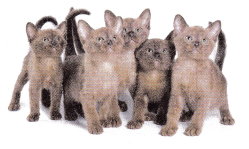
Make a visual model to show the number pattern.
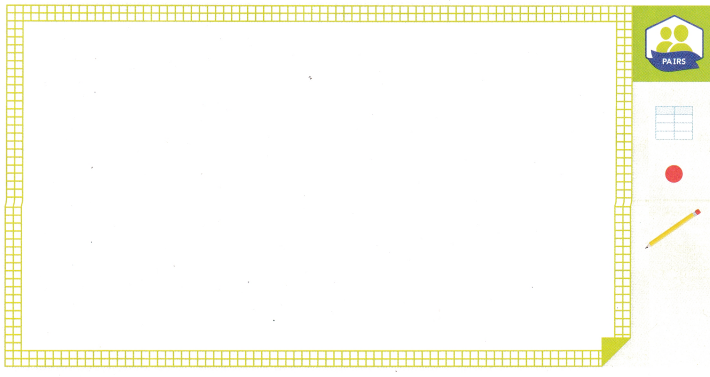
Answer:
There are 30 kittens in 6 litters.
Explanation:
Given that Burmese cats have about 5 kittens per litter and the number pattern shows the number of kittens in 1, 2, 3, 4, and 5 litters. So there are 30 kittens in 6 litters.

Turn and Talk Look at your work. What pattern do you notice?
Build Understanding
1. Serena has a collection of animal stickers. Each week she collects the same number of new stickers and then records the total. If the pattern continues, how many stickers will be in her collection in the sixth week?
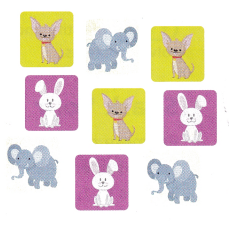

A. What do you do to 1 to get 5? ____
Answer:
1+4 = 5.
Explanation:
To get 5 we will add 4 to 1. So 1+4 = 5.
B. What do you do to 5 to get 9? ____
Answer:
5+4 = 9.
Explanation:
To get 9 we will add 4 to 5. So 5+4 = 9.
C. What do you do to 9 to get 13? ____
Answer:
9+4 = 13.
Explanation:
To get 13 we will add 4 to 9. So 9+4 = 13.
D. What do you do to 13 to get 17? ____
Answer:
13+4 = 17.
Explanation:
To get 17 we will add 4 to 13. So 13+4 = 17.
E. What rule describes the pattern of stickers in the collection? ____
Answer:
The rule that describes the pattern of stickers in the collection is adding 4.
Connect to Vocabulary
A growing pattern changes by the same amount from one number to the next. A rule is an instruction that tells you the correct way to do something. It can be used to describe a growing pattern.
Turn and Talk How do you know this is a growing pattern?
2. downy woodpecker has 4 toes on each foot.
Describe a pattern. Then complete the table.


A. Look across the rows. What pattern can you describe?
_____________________________
Answer:
By looking into the rows the pattern is feet are increasing by 1 and toes are increasing by 4.
B. Now look at the columns. What pattern can you describe?
_____________________________
Answer:
By looking into the columns the pattern is that the feet are multiplied by 4 to get the toes.
C. How can you use your pattern to find how many toes are on 5 feet?
_____________________________
Answer:
20 toes.
Explanation:
In the pattern the toes are multiplied by 4 on feet. So for 5 feet there will be 5×4 = 20 toes.
Turn and Talk Which method, table, or visual model do you prefer to use to extend a pattern? Explain.
Check Understanding Math Board
Question 1.
Describe a pattern. Then write a rule and extend your pattern.
7 12 17 22 27 ____ Rule: _____
Answer:
The next number is 32.
Explanation:
The pattern follows the rule of adding 5 to the before number. So the next number will be 32.
Question 2.
Describe a pattern. Then complete the table.

Answer:
The missing numbers are 32 and 40.
Explanation:
Here, we will multiply number of spiders by 8.

On Your Own
Question 3.
STEM An insect has a pair of antennae on its head and 6 legs attached to its thorax. How many legs do 9 insects have?
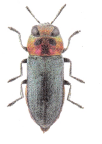
Answer:
The number of legs for 9 insects are 54 legs.
Explanation:
Given that an insect has a pair of antennae on its head and 6 legs attached to its thorax. So the number of legs for 9 insects will be 9×6 = 54 legs.
Use Structure Describe a pattern. Then write a rule and extend your pattern.
Question 4.
13 20 27 34 ________
Rule: ______
Answer:
The next number is 41.
Explanation:
The pattern follows the rule of adding 7 to the before number. So the next number will be 34+7 = 41.
Question 5.
24 37 50 63 76 ____
Rule: ____
Answer:
The next number is 89.
Explanation:
The pattern follows the rule of adding 13 to the before number. So the next number will be 76+13 = 89.
Use Structure Describe a pattern. Then complete the table.
Question 6.

Answer:
The number of paws will be 20.
Explanation:
Here, we have multiplied the number of dogs by 4. So the number of paws will be 5×4 = 20.
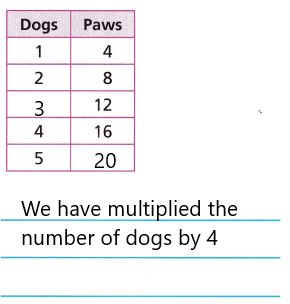
Question 7.
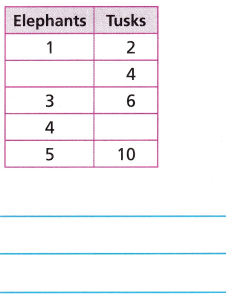
Answer:
Explanation:
The number of tusks will be 8.
Explanation:
Here, we have multiplied the number of elephants by 2. So the number of tusks will be 4×2 = 8.

I’m in a Learning Mindset!
Do I share and accept strategies from others? Explain.
_____________________________
_____________________________